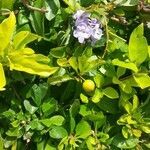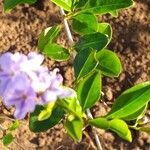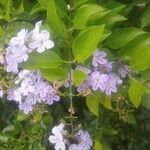Shrub up to 7 m high. Leaves shortly petiolate; petiole (1–) 3–10 (–15) mm long; lamina elliptic-obovate, (15–) 20–75 (–90) mm long, 15–60 mm wide, coarsely serrate above the middle. Inflorescence 100–300 mm long. Flowers fragrant; bracts 1–4 mm long; pedicel 1–5 mm long; calyx 3–7 mm long, canescent outside, glabrous inside; corolla mauve, light bluish purple, glandular in throat, tube 6–10 mm long, the lobes elliptic-oblong or almost orbicular, 3–5 mm long, 2.5–3.5 mm wide; stamens inserted above the middle of the corolla tube; ovary c. 1 mm diam., glabrous; style 2–3 mm long. Fruit orange-yellow, subglobose, glabrous (5–) 7–10 (–14) mm diam.
Shrubs, often climbing. Branches spiny, pubescent when young. Petiole ca. 1 cm, pubescent; leaf blade ovate to lanceolate, 2-6.5 X 1.5-3.5 cm, papery, base cuneate, margin entire to distally crenate, veins 6 pairs. Calyx pubescent on both surfaces. Corolla tube ca. 7 mm. Stamens included. Ovary glabrous. Drupes ca. 5 mm in diam., shorter than calyx, shiny, glabrous. Fl. and fr. May-Oct. 2n = 36.
Leaves opposite or verticillate, petiolate; lamina 1.5–7(8) × 1–3(4) cm, ovate, obovate, ovate-lanceolate or elliptic, acute or obtuse at the apex, cuneate or rounded at the base, entire or serrate on the margins above the middle, glabrous or finely appressed pubescent on both surfaces more densely so on the nerves; petiole 0.5–1.5 cm long, slender, appressed-pubescent.
A shrub or small tree. It is spreading or trailing. It can be evergreen or lose its leaves during the year. It grows 3-6 m tall. It can be spiny or not. The bark is dark brown. The leaves are 2.5-10 cm long by 1-5 cm wide. The flowers are white or purple. The fruit are 6-11 mm across. The fruit are produced in large numbers and are orange. They are poisonous.
Corolla lilac to violet-blue or sometimes white; tube longer than the calyx, curved, puberulous outside more densely so in the upper part, glandular-pubescent within; limb spreading, 7–9 mm in diameter, glandular-pubescent on the upper surface, densely puberulous beneath, lobes 3–5 × 2.5–3.5 mm, oblong to orbicular, densely puberulous.
Racemes many-flowered, 3–16 cm long, single or in lax panicles, the terminal raceme longer than the lateral ones; pedicels 1–5 mm long, alternate, opposite or subopposite; bracts and bracteoles 1.5–2 mm and 1 mm long respectively, linear, those of the lower flowers usually larger and leaf-like.
Spreading, drooping, trailing or subscandent often thorny shrub or small tree up to 6 m high; branchlets slender, 4-angular or terete, young shoots appressed pubescent; spines paired, 0.8–2.7 cm long, axillary or inserted just above the axils, spreading, straight or slightly curved, very sharp.
Small tree or shrub, up to 7 m high. Branchlets glabrate, often drooping, spiny. Leaf blades glabrate beneath, mostly thin-textured, 15-50 mm long. Fruit a drupe, yellow or orange-yellow, enclosed by fruiting calyx. Flowers blue, lilac, violet or light violet-blue, purple.
Fruit yellow to orange-coloured, shiny, 6–11 mm in diameter, globose or obpyriform, completely enveloped by the accrescent calyx the apical part of which forms a curved beak; pyrenes 3.5–5.5 × 2.5–3.5 mm.
Calyx tube 3–4 mm long, ± sparsely appressed-puberulous; teeth up to 1 mm long, triangular with midrib produced as a mucro.
Seeds 2.5–3 × 1–1.5 mm, cuneiform, white, smooth.
Filaments glandular-pubescent, c. 1.25 mm long.













